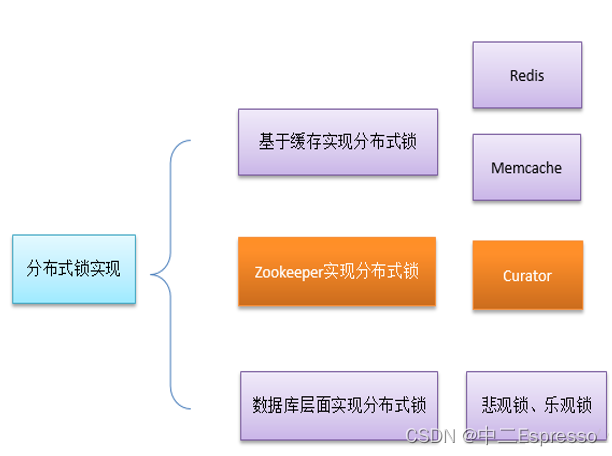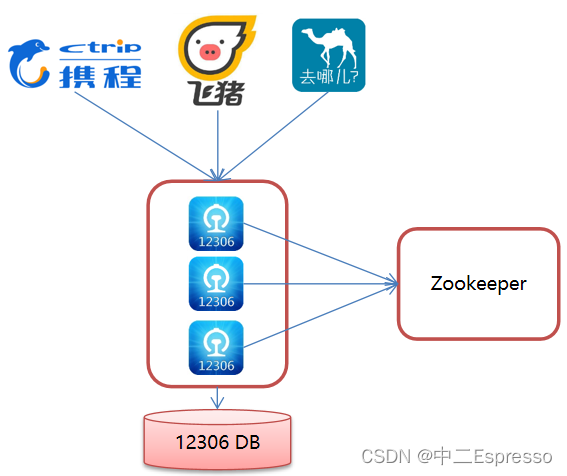Zookeeper-JavaApI操作
JavaApI操作
- JavaApI操作
- 1) Curator 介绍
- 2) Curator API 常用操作
- a) 建立连接与CRUD基本操作
- b) Watch事件监听
- c) 分布式锁
- c.1) 介绍
- c.2) Zookeeper分布式锁原理
- c.3) 案例:模拟12306售票
JavaApI操作
1) Curator 介绍
Curator 是 Apache ZooKeeper 的Java客户端库。
常见的ZooKeeper Java API :
- 原生Java API
- ZkClient
- Curator
Curator 项目的目标是简化 ZooKeeper 客户端的使用。
Curator 最初是 Netfix 研发的,后来捐献了 Apache 基金会,目前是 Apache 的顶级项目。
官网:http://curator.apache.org/
2) Curator API 常用操作
a) 建立连接与CRUD基本操作
Curator API 常用操作:
- 建立连接
- 第一种方法:CuratorFrameworkFactory.newClient
- 第二种方法:CuratorFrameworkFactory.builder() 推荐
/**
* 建立连接
*/
@Test
public void testConnect() {/*** connectString – 连接字符串 zk server 地址和端口 "192.168.200.130:2181"* sessionTimeoutMs – 会话超时时间 单位ms* connectionTimeoutMs – 连接超时时间 单位ms* retryPolicy – 重试策略*/RetryPolicy retryPolicy = new ExponentialBackoffRetry(3000, 10);// 1.第一种方式CuratorFramework client1 = CuratorFrameworkFactory.newClient("192.168.200.130:2181", 60 * 1000, 15 * 1000, retryPolicy);client1.start();// 2.第二种方式CuratorFramework client2 = CuratorFrameworkFactory.builder().connectString("192.168.200.130:2181").sessionTimeoutMs(60 * 1000).connectionTimeoutMs(15 * 1000).retryPolicy(retryPolicy).namespace("dcy") // 名称空间.build();client2.start();
}
- 添加节点
- 如果创建节点,没有指定数据,则默认将当前客户端的ip作为数据存储
- 默认类型:持久化
- creatingParentsIfNeeded 如果父节点不存在,则创建父节点
/**
* 创建节点: create 持久 临时 顺序 数据
*/
@Test
public void testCreate1() throws Exception {// 1.基本创建// 如果创建节点,没有指定数据,则默认将当前客户端的ip作为数据存储String rs = client2.create().forPath("/app1");System.out.println("rs = " + rs);
}@Test
public void testCreate2() throws Exception {// 2.创建节点 带有数据String rs = client2.create().forPath("/app2", "hehe".getBytes());System.out.println("rs = " + rs);
}@Test
public void testCreate3() throws Exception {// 3.设置节点的类型// 默认类型:持久化String rs = client2.create().withMode(CreateMode.EPHEMERAL).forPath("/app3");System.out.println("rs = " + rs);
}@Test
public void testCreate4() throws Exception {// 4.创建多级节点// creatingParentsIfNeeded 如果父节点不存在,则创建父节点String rs = client2.create().creatingParentsIfNeeded().forPath("/app4/p1");System.out.println("rs = " + rs);
}
- 删除节点
- 1.删除单个节点
delete().forPath() - 2.删除带有子节点的节点
delete().deletingChildrenIfNeeded().forPath() - 3.必须成功的删除(为了防止网络抖动,本质是重试)
delete().guaranteed().forPath() - 4.回调
inBackground
- 1.删除单个节点
/**
* 删除节点: delete, deleteall
*/
@Test
public void testDelete1() throws Exception {// 1.删除单个节点client2.delete().forPath("/app1");
}@Test
public void testDelete2() throws Exception {// 2.删除带有子节点的节点client2.delete().deletingChildrenIfNeeded().forPath("/app4");
}@Test
public void testDelete3() throws Exception {// 3.必须成功的删除 (可能会因为网络抖动等原因,操作超时)client2.delete().guaranteed().forPath("/app2");
}@Test
public void testDelete4() throws Exception {// 4.回调client2.delete().guaranteed().inBackground(new BackgroundCallback() {@Overridepublic void processResult(CuratorFramework client, CuratorEvent event) throws Exception {System.out.println("我被删除了~");System.out.println(event);}}).forPath("/app1");
}
- 修改节点
- 1.修改数据
setData().forPath() - 2.根据版本修改
setData().withVersion().forPath()- version 是通过查询出来的,目的是为了让其他客户端和线程不干扰我
- 1.修改数据
/**
* 修改数据
*/
@Test
public void testSet() throws Exception {client2.setData().forPath("/app1", "dcy".getBytes());
}@Test
public void testSetForVersion() throws Exception {Stat stat = new Stat();client2.getData().storingStatIn(stat).forPath("/app1");int version = stat.getVersion(); // 查询出来client2.setData().withVersion(version).forPath("/app1", "haha".getBytes());
}
- 查询节点
- 1.查询数据:get:
getData().forPath() - 2.查询子节点:ls:
getChildren().forPath() - 3.查询节点状态信息:ls -s:
getData().storingStatIn(状态对象).forPath()
- 1.查询数据:get:
/**
* 查询节点:
* 1.查询数据:get: getData().forPath()
* 2.查询子节点:ls: getChildren().forPath()
* 3.查询节点状态信息:ls -s: getData().storingStatIn(状态对象).forPath()
*/
@Test
public void testGet1() throws Exception {// 1.查询数据:getbyte[] bytes = client2.getData().forPath("/app1");System.out.println(new String(bytes));
}@Test
public void testGet2() throws Exception {// 2.查询子节点:lsList<String> path = client2.getChildren().forPath("/");System.out.println(path);
}@Test
public void testGet3() throws Exception {// 3.查询节点状态信息:ls -sStat status = new Stat();client2.getData().storingStatIn(status).forPath("/app1");System.out.println("status = " + status);
}
b) Watch事件监听
ZooKeeper 允许用户在指定节点上注册一些Watcher,并且在一些特定事件触发的时候,ZooKeeper 服务端会将事件通知到感兴趣的客户端上去,该机制是 ZooKeeper 实现分布式协调服务的重要特性。
ZooKeeper 中引入了Watcher机制来实现了发布/订阅功能能,能够让多个订阅者同时监听某一个对象,当一个对象自身状态变化时,会通知所有订阅者。
ZooKeeper 原生支持通过注册Watcher来进行事件监听,但是其使用并不是特别方便 需要开发人员自己反复注册Watcher,比较繁琐。
Curator引入了 Cache 来实现对 ZooKeeper 服务端事件的监听。
ZooKeeper提供了三种Watcher:
- NodeCache : 只是监听某一个特定的节点
- PathChildrenCache : 监控一个ZNode的子节点.
- TreeCache : 可以监控整个树上的所有节点,类似于PathChildrenCache和NodeCache的组合
1.NodeCache : 监听一个特定的节点
/**
* 演示NodeCache
*/
@Test
public void testNodeCache() throws Exception {// 1.创建NodeCache监听对象final NodeCache nodeCache = new NodeCache(client, "/app1");// 2.注册监听nodeCache.getListenable().addListener(new NodeCacheListener() {@Overridepublic void nodeChanged() throws Exception {System.out.println("节点变化~~~");// 获取修改节点后的数据byte[] data = nodeCache.getCurrentData().getData();System.out.println(new String(data));}});// 3.开启监听,如果设置true,则开启监听是,加载缓存数据nodeCache.start(true);while (true) {}
}
2.PathChildrenCache:监听某个节点的所有子节点
/**
* 演示PathChildrenCache:监听某个节点的所有子节点
*/
@Test
public void testPathChildrenCache () throws Exception {// 1.创建监听对象PathChildrenCache pathChildrenCache = new PathChildrenCache(client, "/app2", true);// 2.绑定监听器pathChildrenCache.getListenable().addListener(new PathChildrenCacheListener() {@Overridepublic void childEvent(CuratorFramework client, PathChildrenCacheEvent event) throws Exception {System.out.println("子节点变化~~~");System.out.println("event = " + event);// 监听子节点的数据变更,并且拿到变更后的数据// 1.获取类型PathChildrenCacheEvent.Type type = event.getType();// 2.判断类型是否是updateif (type.equals(PathChildrenCacheEvent.Type.CHILD_UPDATED)) {byte[] data = event.getData().getData();System.out.println(new String(data));}}});// 3.开启监听pathChildrenCache.start();while (true) {}
}
3.TreeCache:监听某个节点自己和所有的子节点
/**
* 演示TreeCache:监听某个节点自己和所有的子节点
*/
@Test
public void testTreeCache () throws Exception {// 1.创建监听器TreeCache treeCache = new TreeCache(client, "/app2");// 2.注册监听treeCache.getListenable().addListener(new TreeCacheListener() {@Overridepublic void childEvent(CuratorFramework client, TreeCacheEvent event) throws Exception {System.out.println("节点变化了");System.out.println("event = " + event);}});// 3.开启监听treeCache.start();while (true) {}
}
c) 分布式锁
c.1) 介绍
在我们进行单机应用开发,涉及并发同步的时候,我们往往采用synchronized或者Lock的方式来解决多线程间的代码同步问题,这时多线程的运行都是在同一个JVM之下,没有任何问题。
但当我们的应用是分布式集群工作的情况下,属于多JVM下的工作环境,跨JVM之间已经无法通过多线程的锁解决同步问题。

那么就需要一种更加高级的锁机制,来处理种跨机器的进程之间的数据同步问题——这就是分布式锁。

c.2) Zookeeper分布式锁原理
核心思想:当客户端要获取锁,则创建节点,使用完锁,则删除节点
- 1.客户端获取锁时,在lock节点下创建临时顺序节点
- 2.然后获取lock下面的所有子节点,客户端获取到所有的子节点后。如果发现自己创建的节点顺序最小,那就认为该客户端获取到了锁。使用完锁后,将该节点删除
- 3.如果发现自己创建的节点并发lock所有子节点中最小的,说明自己还没有获取到锁。此时客户端需要找到比自己小的那个节点,同时对其注册事件监听器,监听删除事件
- 4.如果发现比自己小的那个节点被删除,则客户端的Watcher会收到相应通知,此时再次判断自己创建的节点 是否是lock子节点中序号最小的。如果是则获取到了锁,如果不是则重复以上步骤继续获取到比自己小的一个节点,并注册监听。
c.3) 案例:模拟12306售票
Curator实现分布式锁API
在Curator中有五种锁方案:
- InterProcessSemaphoreMutex:分布式排它锁(非可重入锁)
- InterProcessMutex:分布式可重入排它锁
- InterProcessReadWriteLock:分布式读写锁
- InterProcessMultiLock:将多个锁作为单个实体管理的容器
- InterProcessSemaphoreV2:共享信号量

// 测试类
public class LockTest {public static void main(String[] args) {Ticket12306 ticket12306 = new Ticket12306();// 创建客户端Thread t1 = new Thread(ticket12306, "携程");Thread t2 = new Thread(ticket12306, "飞猪");t1.start();t2.start();}
}// Ticket12306
public class Ticket12306 implements Runnable{private int tickets = 10; // 数据库的票数private InterProcessMutex lock; // 创建锁public Ticket12306() {RetryPolicy retryPolicy = new ExponentialBackoffRetry(3000, 10);CuratorFramework client = CuratorFrameworkFactory.builder().connectString("192.168.200.130:2181").sessionTimeoutMs(60 * 1000).connectionTimeoutMs(15 * 1000).retryPolicy(retryPolicy).build();client.start();this.lock = new InterProcessMutex(client, "/lock");}@Overridepublic void run() {while (true) {try {// 获取锁lock.acquire(3, TimeUnit.SECONDS);if (tickets > 0) {System.out.println(Thread.currentThread().getName() + ":" + tickets);tickets--;}} catch (Exception e) {e.printStackTrace();} finally {// 释放锁try {lock.release();} catch (Exception e) {e.printStackTrace();}}}}
}
